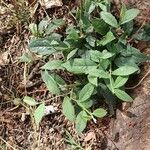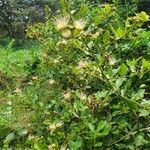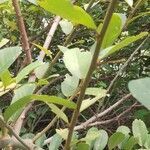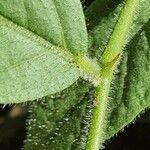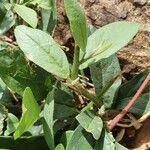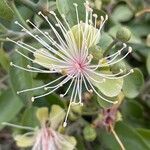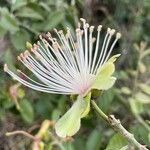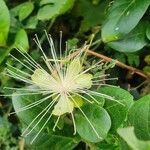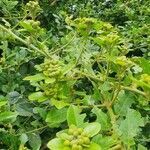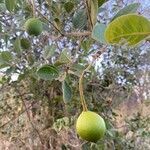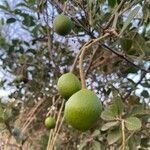Scrambler, shrub or tree-1ike, usually a very robust plant. Branches yellow tomentose, rarely becoming glabrous when old, with recurved, tomentose spines. Leaves alternate, spirally arranged; lamina oblong or broadly elliptic, apex obtuse, emarginate, mucronulate, truncate at the base, 3.5-8 cm long, 1.5-2.5(-3) cm broad, pubescent, becoming glabrous on the upper surface, with 5-8 pairs of secondary veins; petiole 0.4-1.2 cm long, tomentose. Inflorescence terminal, corymbose; pedicels 1.5-2.5 cm long, tomentose. Sepals orbicular, outer ones often fused for 1-2 mm, inner ones free, broadly obovate, rarely oblanceolate, 1.2-2 cm long, puberulous to glabrous, with margin crisped or serrulate. Stamens 45-60; filaments 2.5-3 cm long. Gynophore 2.5-3.5(-5) cm long, glabrous. Ovary ovoid with 30 or more ovules; stigma indistinct, sessile. Berry spherical, up to 4 cm in diameter, glabrous, brownish or yellowish, with numerous seeds embedded in a pink flesh.
It is a spiny scrambling shrub or dense climber. The trunk can be 13-15 cm across and is covered with spines. The branches are covered with thick yellow hairs. The leaves are soft and grey-green. They are oval and 2.5-7 cm long and 1.5-4 cm wide. They have a rounded tip with short sharp point. The spines grow in the axils of the leaves. They are short, hooked and point downwards. The flower buds are round and velvety. They grow in clusters at the ends of branches. The flowers are large, pale green and have a smell. The fruit are long and hang downwards. They have a stout neck and stalk. They are reddish orange when ripe.
Tree, shrub, climber or scrambler, 1-15 m high; robust plant, branches yellow, tomentose; spines recurved, tomentose. Leaves alternate, spirally arranged, petiolate, pubescent, glabrous on upper surface, oblong to broadly elliptic, emarginate, mucronulate. Inflorescence terminal corymbose. Sepals orbicular; outer ones often fused for 1-2 mm; inner ones free, broadly obovate, puberulous to glabrous, margins crisped or serrulate. Stamens 45-60. Ovary ovoid. Fruit a spherical berry, glabrous, brownish or yellowish. Seeds many, embedded in a pink flesh.
Leaf-lamina 3–6 x 1.5–3 cm., oblong or elliptic, rounded and mucronulate or slightly emarginate at the apex, rounded or broadly cuneate at the base, tomentose, thinly hairy or glabrescent above, ± tomentose below; petioles 5–10 mm. long, densely pubescent.
A spiny, erect or scrambling shrub 1–3 m. tall or climbing over other vegetation to 6 m. or perhaps more; young branches covered with a dense, greyish or brownish pubescence; shorter side-branches often at right angles to the main stems.
Flowers scented, in terminal corymbs of 3–15 flowers, the lower pedicels solitary in the axils of the upper leaves, the upper with linear tomentose bracts c. 3 mm. long; pedicels up to 3 cm. long, densely pubescent.
Scrambler, shrub or tree-like. Branches yellow tomentose, with recurved, tomentose spines. Sepals tomentose. Gynophore 25-50 mm long. Fruit 30-50 mm in diameter. Flowers white.
Petals pale yellowish-green, spathulate or cuneiform-truncate at the apex, with white hairs at the base within.
Sepals 8–10 mm. long, orbicular, with a caducous greyish or brownish tomentum outside.
Fruit up to 5 cm. in diam., globose, reddish-orange, on a very stout gynophore.
Seeds c. 1.4 x 0.8 cm. when mature, ovoid, smooth, embedded in a pinkish flesh.
Stamens c. 80 with white or pinkish slender filaments up to 4 cm. long.
Ovary ovoid, bluntly apiculate at the apex.
Gynophore up to 4 cm. long, slender.
Buds globose.
